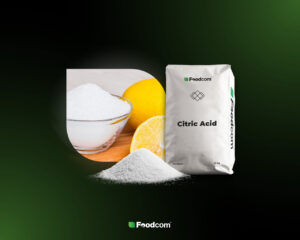- Caractéristiques et origine : l’acide citrique (E330) est un composé chimique naturel présent dans les fruits et également utilisé sous forme synthétique.
- Propriétés : abaisse le pH, prolonge la durée de conservation des produits, possède des propriétés blanchissantes et exfoliantes.
- Utilisations : utilisé dans l’industrie alimentaire, cosmétique et pharmaceutique, comme agent de nettoyage et conservateur d’aliments pour animaux.
- Sécurité : l’acide citrique est sans danger en quantités modérées, mais une utilisation excessive peut entraîner des irritations.
Qu’est-ce que l’acide citrique ?
L’acide citrique (E330), également connu sous le nom d’acide citrique, est un composé chimique organique, classé parmi les AHA, ou acides alpha-hydroxylés. La formule de l’acide citrique est C₆H₈O₇. Il est présent à l’état naturel non seulement dans les citrons, comme son nom l’indique, mais aussi dans des fruits tels que les oranges, les cassis, les fraises ou les ananas. L’acide est également présent dans la plupart des organismes : c’est un produit intermédiaire important du cycle de Krebs (également connu sous le nom de cycle de l’acide citrique), où il joue un rôle important dans le processus de combustion des hydrates de carbone.
Il peut également être produit chimiquement, principalement par fermentation citrique, à l’aide d’enzymes et de souches de bactéries, le plus souvent Aspergillus niger.
Propriétés de l’acide citrique
L’acide citrique se présente sous la forme de cristaux blancs et inodores. Il a cependant un goût aigre assez prononcé.
Il possède un certain nombre de propriétés utiles. Tout d’abord, lorsqu’il est ajouté à des produits, il abaisse leur pH. Cette acidification permet aux articles de durer plus longtemps. Un pH plus bas rend également les vitamines, les micronutriments ou les antioxydants contenus dans les aliments plus stables et mieux absorbés. L’acide dérivé des agrumes a bien sûr aussi pour effet de rendre le goût des produits plus acide.
Il contribue à maintenir la couleur d’origine des produits, par exemple des fruits et des légumes. Il a également un effet blanchissant.
L’acide citrique est considéré comme une substance sûre. S’il est consommé avec modération, il ne provoque pas d’effets secondaires nocifs.
Utilisations de l’acide citrique
L’acide citrique est utilisé dans de nombreuses industries. En raison de ses propriétés – son effet sur le pH, le goût, la couleur et la durée de conservation des produits – il est surtout utilisé dans l’industrie alimentaire.
L’acide citrique est également utiliséen cosmétique , en raison de ses propriétés exfoliantes, éclaircissantes et régulatrices du pH, qui contribuent à améliorer l’état de la peau, à réduire l’apparence des taches et à favoriser l’hydratation de la peau. Il est également utilisé dans la fabrication de produits de nettoyage et dans l’industrie pharmaceutique en tant qu’additif aux médicaments, où il agit comme une substance tampon, soutenant leur efficacité.
En outre, l’acide citrique a trouvé sa place dans l’alimentation animale : il a un effet conservateur sur les aliments et améliore l’absorption du phosphore et le goût des aliments, ce qui se traduit par une augmentation de la consommation d’aliments.
L’acide citrique dans l’alimentation
Additif alimentaire, il apparaît sous la forme E330 sur les étiquettes. Il est excellent pour prolonger la durée de conservation des produits et aider à préserver leur couleur. Bien entendu, il permet également aux aliments de conserver une bonne acidité et constitue un excellent conservateur. En outre, il possède des propriétés liantes et épaississantes, ce qui explique qu’il soit ajouté aux sauces, aux confitures ou aux gelées.
L’acide citrique est également utilisé dans l’industrie de la confiserie et de la boulangerie, où il est ajouté au bicarbonate de soude pour faire lever les gâteaux. En tant qu’acidifiant, il est également un ingrédient important dans la production de fromage, de bière ou de vin.
L’acide citrique n’apparaît pas seulement comme ingrédient dans l’alimentation humaine, mais aussi dans l’alimentation animale. La supplémentation en cet ingrédient a montré des effets positifs sur l’amélioration des performances et de la minéralisation osseuse chez les poulets de chair et sur la croissance des porcelets sevrés. Grâce à l’ajout d’acide citrique, les aliments restent frais plus longtemps et sont plus savoureux, ce qui augmente la consommation et le poids des animaux.
L’acide citrique dans les cosmétiques
La propriété la plus populaire de l’acide citrique utilisé en cosmétique est sa capacité à blanchir l’épiderme. C’est pourquoi on le retrouve comme ingrédient dans les produits destinés aux personnes présentant des décolorations et un teint inégal.
L’acide citrique manifeste également ses effets sur la peau dans le cadre de la prévention du vieillissement, en contribuant à atténuer les rides. Il agit sur le nombre de glycosaminoglycanes contenus dans la peau, dont la fonction est de remplir les espaces intercellulaires. Elle agit sur le nombre de glycosaminoglycanes contenus dans la peau, dont la fonction est de remplir les espaces intercellulaires.
Ila également un effet exfoliant doux, c’est pourquoi il apparaît comme ingrédient dans les gommages, renforçant l’action des autres acides utilisés. Il peut être utilisé dans les produits de soins capillaires : l’abaissement du pH rend les cheveux moins statiques, plus brillants et plus lisses.
L’acide citrique dans l’industrie pharmaceutique
L’acide citrique est largement utilisé dans l’industrie pharmaceutique, où il sert principalement de substance tampon et stabilisante et de régulateur d’acidité. Grâce à ses propriétés de régulation du pH, il est utilisé dans diverses formulations de médicaments telles que les préparations orales, les gouttes pour les yeux et les solutions injectables pour maintenir leur stabilité chimique et augmenter la biodisponibilité des ingrédients actifs. En outre, l’acide citrique agit comme un conservateur, protégeant les produits pharmaceutiques de la croissance microbienne et prolongeant leur durée de conservation. Sa capacité à lier les ions métalliques, grâce à ses propriétés chélatrices, empêche ces ions d’affecter négativement les substances actives des médicaments. L’acide citrique contribue ainsi à l’efficacité et à la durabilité de nombreuses préparations médicales, les rendant plus sûres et plus efficaces.
L’acide citrique comme détartrant et nettoyant
En plus d’être un ingrédient dans les cosmétiques et les aliments, l’acide citrique est également un agent de nettoyage populaire utilisé dans tous les ménages. Sous forme de poudre, il est idéal pour nettoyer diverses surfaces et pour détartrer les bouilloires et autres appareils. Pour détartrer efficacement, il suffit d’ajouter quelques cuillères à café d’acide citrique, de verser de l’eau et de faire bouillir l’eau dans la bouilloire – ce processus entraîne la dissolution du tartre, laissant l’appareil propre et prêt à l’emploi. L’acide citrique peut également être utilisé pour détartrer la vaisselle et comme ingrédient dans les produits de nettoyage. Grâce à son action nettoyante et détartrante polyvalente, il est apprécié dans tous les foyers, à la fois pour garder la vaisselle propre et pour éliminer efficacement les dépôts.
La nocivité de l’acide citrique
L’acide est reconnu comme une substance sûre pour les industries alimentaire, cosmétique et pharmaceutique, à condition qu’il soit utilisé en quantités modérées. Toutefois, une utilisation excessive peut entraîner certains problèmes de santé, tels que l’irritation des muqueuses, en particulier chez les personnes sensibles. En cas de contact avec les yeux, l’acide peut provoquer des brûlures et des rougeurs. L’ingestion d’une trop grande quantité de E330 peut entraîner une irritation du tractus gastro-intestinal, provoquant des douleurs abdominales ou une gêne. Chez les personnes à la peau sensible, l’acide citrique en forte concentration peut provoquer des irritations. Il convient donc d’être prudent lors de l’utilisation de produits cosmétiques contenant cette substance, en particulier si votre peau est sujette à des allergies ou à des lésions.
Notre équipe d’assistance aux ventes aide nos partenaires commerciaux à effectuer des transactions commerciales de manière efficace et efficiente afin de garantir la meilleure qualité de service à tous nos partenaires commerciaux. Notre équipe logistique s’occupe du transport et notre département financier est responsable de toutes les questions liées à la partie financière de la transaction.










